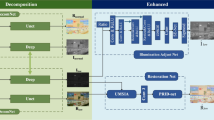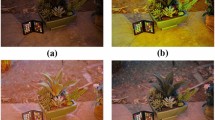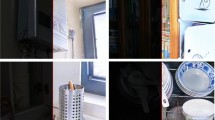Abstract
High-quality clear image can not only bring a good subjective feeling, but also provide good performance guarantee for subsequent computer vision tasks in practical industrial applications. How to improve the low-light image quality and obtain clear image is a challenging task in computer vision. In order to ensure that clear images can be obtained under harsh lighting conditions, we propose a new low-light image enhancement network with decomposition and adaptive information fusion strategy. It firstly decomposes the image by decomposition network, which can obtain a reflection map with more details. Next, a brightness perception network is used to obtain the global and local brightness features of the input image. In addition, we employ an adaptive information fusion module (AIFM) to deal with the redundant information and noise in the multiple features. The experimental results show that the proposed network can not only restore the visually satisfactory image brightness, but also effectively remove the noise and get clear enhancement results. Specifically, the proposed method can achieve 22.20dB PSNR and 0.8380 SSIM gain on LOL dataset, which is the best performance and significantly improved compared with the state-of-the-art methods. We also illustrate the performance by NIQE scores with the proposed method and other comparable algorithms on several other real-world low-light benchmarks datasets including NPE, DICM and LIME, which also indicate that the proposed method has good generalization ability and superiority.













Similar content being viewed by others
References
Abdullah-Al-Wadud M, Kabir MH, Dewan MAA, Chae O (2007) A dynamic histogram equalization for image contrast enhancement. IEEE Trans Consum Electron 53(2):593–600
Acharya A, Giri AV (2020) Contrast improvement using local gamma correction. In: 2020 6th international conference on advanced computing and communication systems (ICACCS), pp 110–114, IEEE
Bertalmío M, Caselles V, Provenzi E, Rizzi A (2007) Perceptual color correction through variational techniques. IEEE Trans Image Process 16(4):1058–1072
Cai J, Gu S, Zhang L (2018) Learning a deep single image contrast enhancer from multi-exposure images. IEEE Trans Image Process 27(4):2049–2062
Celik T, Tjahjadi T (2011) Contextual and variational contrast enhancement. IEEE Trans Image Process 20(12):3431–3441
Chen C, Chen Q, Xu J, Koltun V (2018) Learning to see in the dark. In: Proceedings of the IEEE conference on computer vision and pattern recognition, pp 3291–3300
Cheng H, Shi X (2004) A simple and effective histogram equalization approach to image enhancement. Digital Signal Process 14(2):158–170
Fu X, Zeng D, Huang Y, Ding X, Zhang XP (2013) A variational framework for single low light image enhancement using bright channel prior. In: 2013 IEEE global conference on signal and information processing, pp 1085–1088, IEEE
Fu X, Zeng D, Huang Y, Liao Y, Ding X, Paisley J (2016) A fusion-based enhancing method for weakly illuminated images. Signal Process 129:82–96
Fu X, Zeng D, Huang Y, Zhang XP, Ding X (2016) A weighted variational model for simultaneous reflectance and illumination estimation. In: Proceedings of the IEEE conference on computer vision and pattern recognition, pp 2782–2790
Guo X, Li Y, Ling H (2016) Lime: low-light image enhancement via illumination map estimation. IEEE Trans Image Process 26(2):982–993
He K, Zhang X, Ren S, Sun J (2016) Deep residual learning for image recognition. In: Proceedings of the IEEE conference on computer vision and pattern recognition, pp 770–778
Huang J, Zhu P, Geng M, Ran J, Zhou X, Xing C, Wan P, Ji X (2018) Range scaling global u-net for perceptual image enhancement on mobile devices. In: Proceedings of the European conference on computer vision (ECCV) workshops, pp 230–242
Jiang Y, Gong X, Liu D, Cheng Y, Fang C, Shen X, Yang J, Zhou P, Wang Z (2021) Enlightengan: deep light enhancement without paired supervision. IEEE Trans Image Process 30:2340–2349
Jobson DJ, Rahman Zu, Woodell GA (1997) A multiscale retinex for bridging the gap between color images and the human observation of scenes. IEEE Trans Image Process 6(7):965–976
Jobson DJ, Rahman Zu, Woodell GA (1997) Properties and performance of a center/surround retinex. IEEE Trans Image Process 6(3):451–462
Kingma DP, Ba J (2014) Adam: a method for stochastic optimization. arXiv preprint arXiv:1412.6980
Land EH (1977) The retinex theory of color vision. Sci Am 237(6):108–129
Lee C, Lee C, Kim CS (2012) Contrast enhancement based on layered difference representation. In: 2012 19th IEEE international conference on image processing, pp 965–968, IEEE
Li J, Li J, Fang F, Li F, Zhang G (2020) Luminance-aware pyramid network for low-light image enhancement. IEEE Trans Multimed
Li M, Liu J, Yang W, Sun X, Guo Z (2018) Structure-revealing low-light image enhancement via robust retinex model. IEEE Trans Image Process 27(6):2828–2841
Lore KG, Akintayo A, Sarkar S (2017) Llnet: a deep autoencoder approach to natural low-light image enhancement. Pattern Recogn 61:650–662
Lv F, Li Y, Lu F (2021) Attention guided low-light image enhancement with a large scale low-light simulation dataset. Int J Comput Vis 129(7):2175–2193
Lv F, Lu F, Wu J, Lim C (2018) Mbllen: low-light image/video enhancement using cnns. In: BMVC, p 220
Mittal A, Soundararajan R, Bovik AC (2012) Making a “completely blin’’ image quality analyzer. IEEE Signal Process Lett 20(3):209–212
Pisano ED, Zong S, Hemminger BM, DeLuca M, Johnston RE, Muller K, Braeuning MP, Pizer SM (1998) Contrast limited adaptive histogram equalization image processing to improve the detection of simulated spiculations in dense mammograms. J Digital Imaging 11(4):193–200
Ren X, Li M, Cheng WH, Liu J (2018) Joint enhancement and denoising method via sequential decomposition. In: 2018 IEEE international symposium on circuits and systems (ISCAS), pp 1–5. IEEE
Stark JA (2000) Adaptive image contrast enhancement using generalizations of histogram equalization. IEEE Trans Image Process 9(5):889–896
Suganya P, Gayathri S, Mohanapriya N et al (2013) Survey on image enhancement techniques. Int J Comput Appl Technol Res 2(5):623–627
Vonikakis V, Andreadis I, Gasteratos A (2008) Fast centre-surround contrast modification. IET Image Process 2(1):19–34
Wang C, Ye Z (2005) Brightness preserving histogram equalization with maximum entropy: a variational perspective. IEEE Trans Consum Electron 51(4):1326–1334
Wang R, Zhang Q, Fu CW, Shen X, Zheng WS, Jia J (2019) Underexposed photo enhancement using deep illumination estimation. In: Proceedings of the IEEE conference on computer vision and pattern recognition, pp 6849–6857
Wang W, Wei C, Yang W, Liu J (2018) Gladnet: low-light enhancement network with global awareness. In: 2018 13th IEEE international conference on automatic face & gesture recognition (FG 2018), pp 751–755. IEEE
Wang Z, Bovik AC, Sheikh HR, Simoncelli EP (2004) Image quality assessment: from error visibility to structural similarity. IEEE Trans Image Process 13(4):600–612
Wei C, Wang W, Yang W, Liu J (2018) Deep retinex decomposition for low-light enhancement. In: British machine vision conference, pp 1–12
Yang Q, Wu Y, Cao D, Luo M, Wei T (2021) A lowlight image enhancement method learning from both paired and unpaired data by adversarial training. Neurocomputing 433:83–95
Yang W, Wang S, Fang Y, Wang Y, Liu J (2020) From fidelity to perceptual quality: a semi-supervised approach for low-light image enhancement. In: Proceedings of the IEEE/CVF conference on computer vision and pattern recognition, pp 3063–3072
Yue H, Yang J, Sun X, Wu F, Hou C (2017) Contrast enhancement based on intrinsic image decomposition. IEEE Trans Image Process 26(8):3981–3994
Zhang Y, Guo X, Ma J, Liu W, Zhang J (2021) Beyond brightening low-light images. Int J Comput Vis 129(4):1013–1037
Zhang Y, Zhang J, Guo X (2019) Kindling the darkness: a practical low-light image enhancer. In: Proceedings of the 27th ACM international conference on multimedia, pp 1632–1640
Zhu M, Pan P, Chen W, Yang Y (2020) Eemefn: low-light image enhancement via edge-enhanced multi-exposure fusion network. In: AAAI, pp 13106–13113
Acknowledgements
This study was funded by the Natural Science Foundation of Liaoning Province(No. 2020–MS–080), the National Natural Science Foundation of China(No. 61772125)
Author information
Authors and Affiliations
Corresponding author
Ethics declarations
Conflicts of interest
The authors declare that they have no conflict of interest.
Additional information
Publisher's Note
Springer Nature remains neutral with regard to jurisdictional claims in published maps and institutional affiliations.
Rights and permissions
About this article
Cite this article
Zhu, H., Wang, K., Zhang, Z. et al. Low-light image enhancement network with decomposition and adaptive information fusion. Neural Comput & Applic 34, 7733–7748 (2022). https://doi.org/10.1007/s00521-021-06836-4
Received:
Accepted:
Published:
Issue Date:
DOI: https://doi.org/10.1007/s00521-021-06836-4




